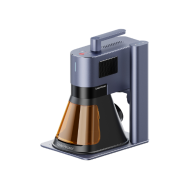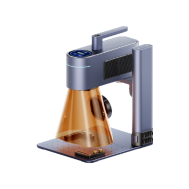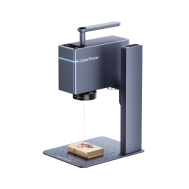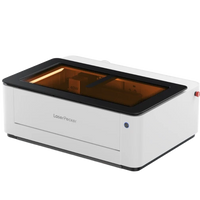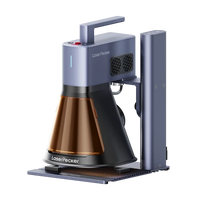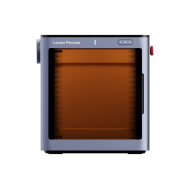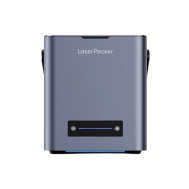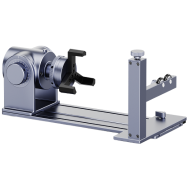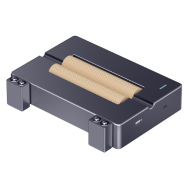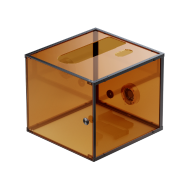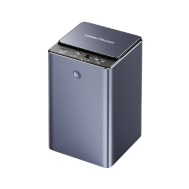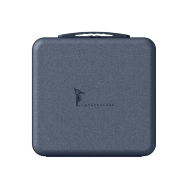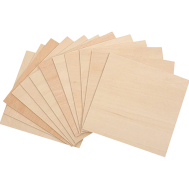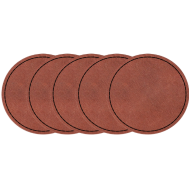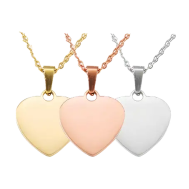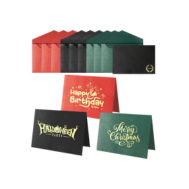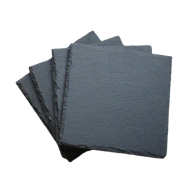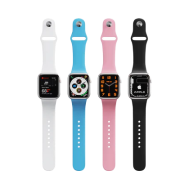A watch is more than just something that tells time; it's a piece of your story right there on your wrist. A watch can mark a special gift, a big achievement, or just say thanks. Engraving it makes it super personal. Before you go ahead and add that message or those initials, it helps to know what's involved, what options you have for engraving, and how to dodge any damage to your watch or its warranty.
In this guide, we'll look at why engraving a watch is a great idea. We'll check out the different ways to do it, look at the good and bad sides of each, and show you how to get a watch engraved safely.

In this article:
- Part 1: Why Engrave a Watch
- Part 2: 5 Methods to Engrave Things on a Watch
- Method 1: Laser Engraving
- Method 2: Hand Engraving
- Method 3: Mechanical Engraving (CNC/Hob)
- Method 4: Chemical Etching
- Method 5: Electrochemical Etching
- Part 3: How to Engrave a Watch with LaserPecker LP5
- Part 4: Tips for Engraving a Watch
- Part 5: FAQs for Getting a Watch Engraved
Part 1: Why Engrave a Watch?
Engraving adds a personal touch to your watch, building a stronger bond with it. Here's why people get watches engraved:

- Personalize it: Add your initials, name, or important dates.
- Remember important times: Mark anniversaries, graduations, or wins.
- Add meaning: A short message can make a watch a treasured gift.
- Branding: Businesses engrave watches for awards or gifts.
- Create a family heirloom: Pass down a message through generations.
Engraving is special, but be careful. The wrong method or placement can damage the watch's look or water resistance. Let's look at how professional engravers do it right.
Part 2: 5 Methods to Engrave Things on a Watch
There are different ways to engrave a watch, which depend on things like what it's made of, how much you want to spend, the look you're going for, and how detailed you need it to be. Each way has its own benefits.
Method 1: Laser Engraving
Laser engraving uses a strong beam emitted by laser engraver to vaporize material on watch's surfaces very precisely. It is clean and fast and works great for both words and images. Fiber lasers are often used on metals like stainless steel and titanium. Diode lasers work nicely on things like coated surfaces, leather, and plastics.
Method 2: Hand Engraving
Hand engraving stands out as the oldest and most artistic way to decorate items. Skilled people use tools to cut designs into metal by hand. This gives lines full of character that you can't get any other way-great for those high-end or old-school items.
Method 3: Mechanical Engraving (CNC/Hob)
Mechanical engraving carves patterns into metal using a cutting tool or CNC machine. It makes deep, consistent engravings that are the same every time, so it's well-suited for making lots of items or for industrial branding.
Method 4: Chemical Etching
Chemical etching protects some areas while acid or chemicals dissolve the exposed metal. It's good for making shallow, decorative marks and leaves a smooth, dull surface.
Method 5: Electrochemical Etching
This method uses electricity and special liquids to carve designs into metal through a stencil. It's a common way to add serial numbers, logos, or detailed marks to stainless steel parts.
| Method | Best For | Depth / Detail | Speed | Cost | Risk |
|---|---|---|---|---|---|
| Laser | Most metals & coatings | Precise, adjustable | ★★★★★ | $$ | Very low |
| Hand | Luxury & artistic pieces | Deep, unique | ★ | $$$ | Medium |
| CNC | Batch / industrial work | Deep, consistent | ★★★★ | $$ | Medium |
| Chemical | Light marks on metal | Shallow | ★★★ | $ | Low |
| Electrochemical | Logos / serials | Shallow | ★★★★ | $$ | Low |
Laser engraving is the most versatile and precise method, offering clean, consistent results on metals, coatings, and leather. It’s faster and safer than hand, mechanical, or chemical techniques, making it ideal for both personal and professional watch customization.
Part 3: How to Engrave a Watch with LaserPecker LP5
The LaserPecker LP5 has both a 20W fiber laser (1064 nm) and a 20W diode laser (450 nm). That means you can use one machine to engrave anything from metal to other stuff. Here’s how to get a professional-looking engraving on your watch:
Step 1: Plan it Out
Pick what you want to engrave (like a name, date, or logo) and where to put it. The back of the watch is the easiest spot. If you want to do the clasp or band, you might need a special LaserPecker Flexible Fixture.
Step 2: Get the Surface Ready
Wipe the area clean with alcohol to get rid of any oil or dust. Hold the watch steady with a clamp or LaserPecker Flexible Fixture, so it doesn't move around.
Step 3: Pick the Right Laser
Fiber laser (1064 nm): Works best on metals like steel, titanium, or gold.
Diode laser (450 nm): Good for things like coatings, leather straps, plastics, or painted surfaces.
Step 4: Adjust the Settings
Use LightBurn or LaserPecker Design Space to set the power, speed, and number of passes. Try it out on a spare piece of material first to make sure you get the look you want.
Step 5: Engrave Safely
Use the safety enclosure to make the LP5 safe enough to use at home, in a studio, or even in a store. Start engraving and keep an eye on how it looks.
Step 6: Check and Clean
After engraving, check to see if it’s clear and even. Carefully clean off any bits and pieces, and don't polish the engraved area right away.
What's great about the LP5:
- It has two lasers for use on all kinds of materials.
- It's super fast, going up to 10,000 mm/s.
- It can do deep engraving, embossing, and cutting.
- You can add a rotary extension for round stuff like rings, mugs, and bracelets.
- There’s a slide extension you can add to make the work area bigger (160 × 300 mm).
- It works with LightBurn for a smooth, pro-level process.
All this makes the LP5 a great tool for watch lovers, small shops, and businesses that do personalized stuff.
Part 4: Tips for Engraving a Watch
- Before you start, test your settings on something similar to the watch.
- Don't engrave too close to any seals unless you can get the watch resealed by someone who knows what they're doing.
- If you're working with curved watch bracelets or clasps, use a LaserPecker Flexible Fixture to keep everything in focus.
- For PVD/DLC coatings, go with low power and high speed to avoid damage.
- Keep your designs simple and the right size—small watches need tiny text.
- Make sure you have good airflow and wear safety glasses when using the laser.
- Take a picture of your engraving for your files or if you plan to resell it.
Part 5: FAQs for Getting a Watch Engraved
1. Can Any Watch Be Engraved?
Yep, you can get most watches engraved, but whether it works out depends on what they're made of and how they're shaped. Flat, stainless steel backs and clasps are your best bet. If you've got a watch made of ceramic or sapphire, or one that's super curvy, you'll need some fancy equipment. Also, keep an eye on how thick the case is and what kind of finish it has. Some watches are just too thin or delicate, and the heat or pressure from engraving could mess them up. If you're not sure, it's always a good idea to ask a pro engraver or the watch company before you go ahead.
2. Will Engraving Void My Warranty or Water Resistance?
So, getting your watch engraved might mess with the warranty, especially if they gotta crack it open or mess with the seals. Most watch companies aren't gonna cover damage if you've changed stuff on the outside. Now, if you're just engraving the outside, like the clasp or the back, you're probably good as long as they don't have to open it up. To be super safe, get it pressure-tested and resealed by the official service place afterwards to make sure it can still handle water and stuff.
3. How Much Does Watch Engraving Cost, And How Long Does It Take?
How much it costs depends on how it's done, how tricky it is, and what stuff they use. Quick laser jobs, like initials or a few words, usually go for $30–$100 and can be finished in less than an hour. But if you want some really detailed hand-engraved designs, that could set you back hundreds of dollars and take several days to finish. Taking the watch apart, putting it back together, or getting the surface ready can also add to the time. Just be sure to ask how long it'll all take, plus any checks and water tests if you need them.
4. Can I Engrave a Pvd/Dlc or Ceramic Watch?
Yeah, but you gotta be super careful. PVD/DLC coatings are just thin layers to make stuff last longer and look cool. If you engrave through them, you'll show the metal underneath, which looks neat 'cause it's a big difference. But it might make things less protected. For the best result, use the fiber laser setting on something like the LP5. That way, you get good detail without a lot of heat messing things up. Ceramic watches? Those need special lasers. Don't even think about engraving them with regular tools – they'll crack for sure. Always try it out on a spare piece or somewhere you can't see first, just in case.
5. Case Back Vs the Clasp: Where Is It Better to Engrave?
Okay, so here's the deal: Both options have good and bad sides. The back of the case is cool if you want to keep things secret, like a special message or initials just for you. The problem is, you might have to take the case off to get it engraved, and that could mess up the waterproof thing. Now, the clasp or bracelet is out there for everyone to see, and it's safer to engrave without wrecking anything. But there's not as much room, and if you're doing something wild, the curve might mess it up. Basically, if you're all about keeping it personal and hidden, go with the case back. If you want everyone to check out your logo or something easy, pick the clasp.
Conclusion
Engraving makes a watch special by adding a personal touch, like a symbol or memory. Tools such as the LaserPecker LP5 let anyone engrave metal, leather, or coated stuff safely and get great results. Whether it's one gift or many, the LP5 makes personalizing easy and exact.
















